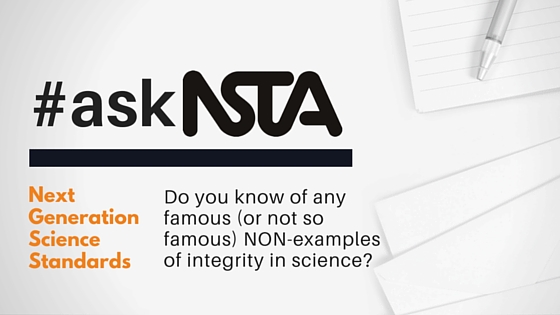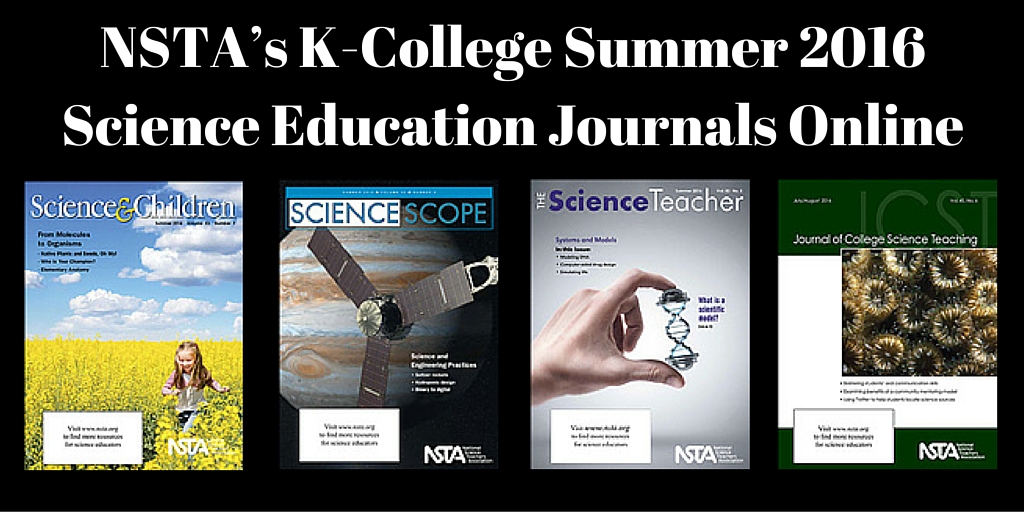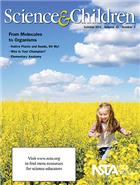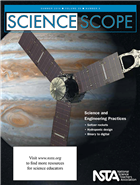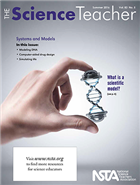Write Grant Proposals That Win
By Carole Hayward
Posted on 2016-07-12
A successful grant application can provide you with the funding you need to do exciting new activities with your students. The only problem is that grant writing is an art form of its own. There’s a new NSTA Press book that can help.
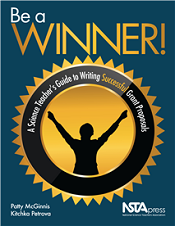 Be a Winner! A Science Teacher’s Guide to Writing Successful Grant Proposals by Patty McGinnis and Kitchka Petrova offers practical tips and strategies to help you write winning proposals.
Be a Winner! A Science Teacher’s Guide to Writing Successful Grant Proposals by Patty McGinnis and Kitchka Petrova offers practical tips and strategies to help you write winning proposals.
“As a science educator, you are concerned with the state of science education in your K-12 schools, and you understand the importance of facilitating your students’ science learning through the science and engineering practices identified in the Next Generation Science Standards (NGSS). Unfortunately, funds for purchasing materials are not always available in schools, thus requiring you to seek outside funding opportunities. Given the economic situation of many school districts, it is more imperative than ever to master the art of grant proposal writing to secure funds for innovative classroom projects,” write McGinnis and Petrova.
How do you even get started? First, you need to come up with a strong idea.
The authors ask readers to consider an important question: “What is your dream for your classroom, school, science department, or community?” This question will lead you think about what you want to accomplish. Next, you will think about what resources are already available for you to tap into before you even begin the grant process.
Just like any scientific activity, there are steps and standards to follow in order to achieve the goal. The authors do an excellent job of breaking down the chunks of the grant proposal process to make it appear less daunting.
Using McGinnis’ and Petrova’s tips to organize your thinking, clarify your objectives, create an elevator speech, and build the required components of the proposal will increase your ability to feel confident and prepared when seeking grant funding. The book even offers suggestions to help you create project ideas that align with the NGSS standards.
“The inclusion of the NGSS performance expectations in your proposal will help your students achieve high standards and increase the value of your proposal,” write McGinnis and Petrova.
Be a Winner! offers a listing of grants and additional grant writing resources and also provides advice about managing your grant-funded project.
This book is for teachers new to grant writing and for pros who want to increase their efficacy.
Get started writing winning grant proposals today! Check out the sample chapter “Getting Started: May the FORCE Be With You! This book is also available as an e-book.
Follow NSTA
Save
Save
A successful grant application can provide you with the funding you need to do exciting new activities with your students. The only problem is that grant writing is an art form of its own. There’s a new NSTA Press book that can help.
Water play…exploration…science inquiry
By Peggy Ashbrook
Posted on 2016-07-11
 Water explorations are a popular in early childhood programs during the summer. Exuberant water explorations can happen outdoors. The experience of wetness is enjoyable and clothes that get wet accidentally can dry on the child rather than having to be changed. Natural materials such as leaves and twigs can be incorporated into the exploration.
Water explorations are a popular in early childhood programs during the summer. Exuberant water explorations can happen outdoors. The experience of wetness is enjoyable and clothes that get wet accidentally can dry on the child rather than having to be changed. Natural materials such as leaves and twigs can be incorporated into the exploration.
To keep the water experiences enjoyable, meaningful and a powerful learning opportunity, take a look at these resources.
 Play is part of every science exploration. Science learning begins very early as children explore the properties of matter and how they can affect it through their play. “Five Essentials to Meaningful Play,” Marcia Nell and Walter Drew’s online column in NAEYC for families, can help other adults understand how children are learning science concepts and much more through their water play. Their book, From Play to Practice: Connecting Teachers’ Play to Children’s Learning is another valuable resource.
Play is part of every science exploration. Science learning begins very early as children explore the properties of matter and how they can affect it through their play. “Five Essentials to Meaningful Play,” Marcia Nell and Walter Drew’s online column in NAEYC for families, can help other adults understand how children are learning science concepts and much more through their water play. Their book, From Play to Practice: Connecting Teachers’ Play to Children’s Learning is another valuable resource.
 Children learn more each time they repeat an experience. Adults who embrace children’s curiosity and encourage questions and problem-solving support children’s learning. Water play can become an inquiry into the properties of water when adults provide additional materials and help children reflect on their observations. Science inquiry is more than single activities about science topics or concepts. The Young Scientist series book, Exploring Water with Young Children, by Karen Worth and Ingrid Chalufour (Redleaf
Children learn more each time they repeat an experience. Adults who embrace children’s curiosity and encourage questions and problem-solving support children’s learning. Water play can become an inquiry into the properties of water when adults provide additional materials and help children reflect on their observations. Science inquiry is more than single activities about science topics or concepts. The Young Scientist series book, Exploring Water with Young Children, by Karen Worth and Ingrid Chalufour (Redleaf  Press) is a guide for using water to help children use the practices of science, investigate flow and how water affects objects. There is also guidance on developing scientific dispositions of eagerness to learn and curiosity. I think it is also helpful in supporting teachers who have not yet taught science concepts, topics, or the nature of science.
Press) is a guide for using water to help children use the practices of science, investigate flow and how water affects objects. There is also guidance on developing scientific dispositions of eagerness to learn and curiosity. I think it is also helpful in supporting teachers who have not yet taught science concepts, topics, or the nature of science.
 NAEYC provides free online access to the article “Promoting Children’s Science Inquiry and Learning Through Water Investigations” by Cindy Hoisington, Ingrid Chalufour, Jeff Winokur, and Nancy Clark-Chiarelli from the October/November 2014 issue of Teaching Young Children and September 2014 issue of Young Children. Read about how to facilitate direct experiences that promote conceptual learning related to water. Learn how to ask questions about phenomena that are connected to concepts and interesting to children, and questions that stimulate children’s inquiry and investigation rather than suggest “correct” answers.
NAEYC provides free online access to the article “Promoting Children’s Science Inquiry and Learning Through Water Investigations” by Cindy Hoisington, Ingrid Chalufour, Jeff Winokur, and Nancy Clark-Chiarelli from the October/November 2014 issue of Teaching Young Children and September 2014 issue of Young Children. Read about how to facilitate direct experiences that promote conceptual learning related to water. Learn how to ask questions about phenomena that are connected to concepts and interesting to children, and questions that stimulate children’s inquiry and investigation rather than suggest “correct” answers.
 The National Science Teachers Association’s (NSTA) position statement on Early Childhood Science Education was endorsed by the National Association for the Education of Young Children (NAEYC). The statement affirms that “Effective science investigations can deeply engage young children for extended periods of time, beyond a single activity or session.” It also offers guidance to educators in principles and declarations.
The National Science Teachers Association’s (NSTA) position statement on Early Childhood Science Education was endorsed by the National Association for the Education of Young Children (NAEYC). The statement affirms that “Effective science investigations can deeply engage young children for extended periods of time, beyond a single activity or session.” It also offers guidance to educators in principles and declarations.
Two examples:
NSTA identifies the following key principles to guide the learning of science among young children.
- Adults play a central and important role in helping young children learn science.
Everyday life is rich with science experiences, but these experiences can best contribute to science learning when an adult prepares the environment for science exploration, focuses children’s observations, and provides time to talk about what was done and seen (NAEYC 2013, p. 18). It is important that adults support children’s play and also direct their attention, structure their experiences, support their learning attempts, and regulate the complexity and difficulty of levels of information (NRC 2007, p. 3). It’s equally important for adults to look for signs from children and adjust the learning experiences to support their curiosity, learning, and understanding. [See the document online for references.]
Declarations
NSTA recommends that teachers and other education providers who support children’s learning in any early childhood setting should
- tap into, guide, and focus children’s natural interests and abilities through carefully planned open-ended, inquiry-based explorations;
 Another resource for expanding a session at the water center into science inquiry is the description of the science and engineering practices in Rodger W. Bybee’s article “Scientific and Engineering Practices in K–12 Classrooms Understanding A Framework for K–12 Science Education” in the December 2011 issue of Science and Children. It is free to read online. Here is a list of the eight practices of science and engineering that the Framework identifies as essential for all students to learn:
Another resource for expanding a session at the water center into science inquiry is the description of the science and engineering practices in Rodger W. Bybee’s article “Scientific and Engineering Practices in K–12 Classrooms Understanding A Framework for K–12 Science Education” in the December 2011 issue of Science and Children. It is free to read online. Here is a list of the eight practices of science and engineering that the Framework identifies as essential for all students to learn:
1. Asking questions (for science) and defining problems (for engineering)
2. Developing and using models
3. Planning and carrying out investigations
4. Analyzing and interpreting data
5. Using mathematics and computational thinking
6. Constructing explanations (for science) and designing solutions (for engineering)
7. Engaging in argument from evidence
8. Obtaining, evaluating, and communicating information.
In my book, Science Learning in the Early Years, there are four column chapters discussing water exploration:
Chapter 24—Water Works, updated from the July 2007 Science and Children
Chapter 33—Adding Up the Rain, updated from the July 2009 Science and Children
Chapter 42—Ongoing inquiry, investigating water, updated from the February 2011 Science and Children
Chapter 52—Water Leaves “Footprints,” updated from the April 2013 Science and Children
I also discussed aspects of water play as part of the NSTA Virtual Conference, Engaging Students in Science: PreK-6.
 The challenges we face in providing effective science education for young children vary from location to location and program to program. In one school the deep sink that allows teachers to fill buckets or small tubs of water only has a hot water option. Those teachers have to plan ahead to fill jugs of water at the end of the day so it will cool down enough for children to work in the following day. Families can be very concerned about children’s clothing getting wet or muddy. We can’t take this lightly—they may not have easy access to laundry facilities or extra sets of clothing. Some programs invest in smocks that cover most of children’s clothing. Other programs use large plastic bags cut open into a smock shape for older children and with close supervision. Programs that do not have a “science budget” make interesting tools for water exploration out of empty milk jugs, dollar store purchases or donations of recyclable containers and turkey basters from families. Leaves and twigs from safe plants make interesting tools. One program that had just a single water table for 5 classrooms bought large shallow storage tubs to use on table tops and even on the ground outside.
The challenges we face in providing effective science education for young children vary from location to location and program to program. In one school the deep sink that allows teachers to fill buckets or small tubs of water only has a hot water option. Those teachers have to plan ahead to fill jugs of water at the end of the day so it will cool down enough for children to work in the following day. Families can be very concerned about children’s clothing getting wet or muddy. We can’t take this lightly—they may not have easy access to laundry facilities or extra sets of clothing. Some programs invest in smocks that cover most of children’s clothing. Other programs use large plastic bags cut open into a smock shape for older children and with close supervision. Programs that do not have a “science budget” make interesting tools for water exploration out of empty milk jugs, dollar store purchases or donations of recyclable containers and turkey basters from families. Leaves and twigs from safe plants make interesting tools. One program that had just a single water table for 5 classrooms bought large shallow storage tubs to use on table tops and even on the ground outside.
Speaking of safe, some programs schedule little paid time for cleaning up at the end of the day. By having children help empty the water table tubs, and tools, we provide the additional learning experience of scooping, feeling the weight of different amounts of water, and making many small amounts out of one large one, while giving children an important role in classroom care. They need to wash hands after water play. The sanitizing process is just for adults, making sure each item is empty and positioned to dry before using a sanitizing spray on all surfaces.
Water play is for all ages! Small amounts and close supervision allow the youngest children to become familiar with “wetness” and taking action to move water through splashing. Water play and science inquiry are a time for conversations that introduce rich vocabulary and provide moments for shared fun.
 Water explorations are a popular in early childhood programs during the summer. Exuberant water explorations can happen outdoors. The experience of wetness is enjoyable and clothes that get wet accidentally can dry on the child rather than having to be changed. Natural materials such as leaves and twigs can be incorporated into the exploration.
Water explorations are a popular in early childhood programs during the summer. Exuberant water explorations can happen outdoors. The experience of wetness is enjoyable and clothes that get wet accidentally can dry on the child rather than having to be changed. Natural materials such as leaves and twigs can be incorporated into the exploration.
Managing Communication Channels
By Mary Bigelow
Posted on 2016-07-11
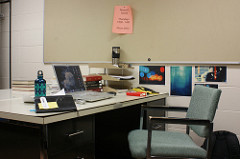 Last year, I tried improving my communications with students and parents via electronic media. I had lots of responses, but I was being texted, tweeted, emailed, and called on the phone at all times of the day and night. While I want to encourage these communications, I’m looking for ideas to manage them and keep my sanity! —G., Colorado
Last year, I tried improving my communications with students and parents via electronic media. I had lots of responses, but I was being texted, tweeted, emailed, and called on the phone at all times of the day and night. While I want to encourage these communications, I’m looking for ideas to manage them and keep my sanity! —G., Colorado
It sounds like you have a case of “be careful what you wish for….” Many teachers would love to have parents and students contacting them, but I can understand how this can become overwhelming.
In a recent article in Educational Leadership (May 2016)*, Catlin Tucker, an English teacher from California, shared her ideas on “avoiding technology overload.” You may find them helpful as you try to manage communications with the many other responsibilities of a science teacher:
- Establish virtual office hours. Just as college professors publish office hours in a course syllabus, let student and parents know when you can be contacted in real time outside of class and when you’ll be able to respond to messages they leave regarding class topics and issues. Post these times on the class website and your online class calendar.
- Choose one communication channel. I hadn’t thought about this, but the author suggests that having a preferred medium helps you be more focused without switching between texting, tweeting, emailing, and traditional phone calls. The author settled on email for non-urgent questions and texting for more immediate needs. Both of these also give you some time to think about the questions or issues before responding. (But if many of your parents do not have email, you still may have to rely on phone calls.)
- Make information available online. Use a class blog, webpage or other online methods to post information and a calendar. Update it frequently with assignments, videos, the syllabus, handouts, rubrics, extra readings, class schedules, and multimedia resources. Include your syllabus and safety acknowledgment form, too. Encourage students to refer to the calendar to try to avoid the “Are we having a test tomorrow?” or “Did I miss anything when I was absent?” type of questions. This means that you will have to update the site on a weekly or daily basis.
- Set up a space where students can connect online. Students often will answer each other’s questions or offer advice. The author suggests having a private community site or forum you can monitor and participate in. You can get feedback on what students find interesting or concerning about your class.
- Protect unplugged time at home. Your personal time is valuable. Teachers need a break to take care of their families, prepare lessons, go to graduate classes, participate in community programs, or have a little “me” time for exercise or relaxation. Let students and parents know when you’ll be online and when you’ll be offline. You should also consider how available you want to be on weekends or holiday breaks.
I would add another suggestion: Protect your class time. I was visiting a classroom where the teacher’s phone rang several times and she received several text messages. She attended to these distractions, which interrupted the lesson. Let parents know that during the day, your phone will be off (or muted) to incoming messages out of respect to your students and the learning process. You will not be able to respond to a message until a planning period, after school, or during your stated office hours. This is especially critical for science teachers supervising students in a laboratory situation. They must have your undivided attention.
One downside of communications technology is the perception that we are “on call” 24/7. You’re wise to consider how to make these communications an efficient and effective asset.
—–
*Five Tips for Avoiding Technology Overload
Photo: https://farm2.staticflickr.com/1181/3172841858_4f317b12f7_m_d.jpg
 Last year, I tried improving my communications with students and parents via electronic media. I had lots of responses, but I was being texted, tweeted, emailed, and called on the phone at all times of the day and night. While I want to encourage these communications, I’m looking for ideas to manage them and keep my sanity!
Last year, I tried improving my communications with students and parents via electronic media. I had lots of responses, but I was being texted, tweeted, emailed, and called on the phone at all times of the day and night. While I want to encourage these communications, I’m looking for ideas to manage them and keep my sanity!
How Can Science Teachers Use Examples of Dishonest Science?
By Lauren Jonas, NSTA Assistant Executive Director
Posted on 2016-07-09
NSTA members ask and answer one anothers’ questions about science teaching every day via the listserv, and the topics are fascinating. The latest question, trending on our NGSS list, focuses on dishonest science. The answers and comments are eye-opening!
Question:
“We’re exploring what it means to be principled and show integrity in science and I’m wondering if you know of any famous (or not so famous) NON-examples of integrity in science? When did dishonesty in reporting data lead to some devastating consequences? Any insights are appreciated!”
—Sara Severance, 8th Grade Physical Science Teacher, McAuliffe International School, Denver, CO
(question shared here with her permission)
Top Answers from NSTA Members
- In 1998 Andrew Wakefield and colleagues published an article in the Lancet that the MMR vaccine may predispose children “to behavioral regression and pervasive developmental disorder”. As a consequence, vaccination rates began to drop, and outbreaks of measles climbed. Other scientists immediately began researching the topic and could not replicate the results. After much investigation and debate, The Lancet completely retracted the article in 2010. Wakefield et al. were found to be guilty of deliberate fraud. If you do a search on this, you will find much more information, but here is a good article: http://www.ncbi.nlm.nih.gov/pmc/articles/PMC3136032/.
- Three quick ones: Univ. of Utah and cold fusion, South Korea and stem cell research, Ptolemy and changing the math/data to fit the heliocentric model of the universe (just covered a few minutes ago in my 8th grade Earth science class).
- I’m not sure if this is what you are thinking of, but the Tuskegee Syphilis Study from 1932-1972 is certainly an example of egregious human rights violations, racism, and deception done in the name of science. I mentioned it in my Introduction to Microbiology class last night. http://www.cdc.gov/tuskegee/timeline.htm
- There’s also the classic case of the Summerlin’s spotted mice. Here’s a fairly recent editorial on the 1974 case, http://w.astro.berkeley.edu/~kalas/ethics/documents/painted-mouse.pdf. It was also reported on by Peter Medawar in his great essay book, The Strange Case of the Spotted Mice and Other Classic Essays in Science.
- Here is an interesting article with links to experiments that – for various reasons including dishonesty and confirmation bias – were not reproducible by others: http://ncse.com/blog/2016/04/now-word-from-captain-obvious-0017038.
- How about Watson & Crick stealing Rosalind Franklin’s data? They end up with the Nobel prize and she dies of cancer.
- I am wondering about Henrietta Lacks and the HeLa Cells. The Smithsonian has some good information on her and there is also the book The Immortal Life of Henrietta Lacks.
- Scott Reuben falsified data on postoperative pain that had a major impact. Here is one link: http://www.scientificamerican.com/article/a-medical-madoff-anesthestesiologist-faked-data/. You can easily find more. I teach 6-8 MYP Integrated Science and use it at the beginning of the year to exemplify ‘Principled’ and ‘consequences’. It’s a pretty appalling case.
- Here’s another one: https://www.washingtonpost.com/news/to-your-health/wp/2015/07/01/researcher-who-spiked-rabbit-blood-to-fake-hiv-vaccine-results-slapped-with-rare-prison-sentence/.
A Word of Caution
Hat Tip to NSTA member Nathan F. for this reminder: “I think we need to be careful of using isolated examples of poor science. Students may extrapolate to “you can’t trust science” instead of ‘peer review is important makes science a self-correcting system.’ This is where we as teachers need to use our expertise. I can envision a list of quality research projects a mile long and a list or poor research much much shorter.”
Join the Conversation
Do you have examples that you use with your students? Please share your comments with us!
Get more involved with NSTA!
Join today and receive NSTA’s peer-reviewed journals; connect on the listserv and get your own questions answered (members can sign up on the list server); or consider joining your peers at an upcoming NSTA Conference on Science Education.
The mission of NSTA is to promote excellence and innovation in science teaching and learning for all.
Future NSTA Conferences
5th Annual STEM Forum & Expo, hosted by NSTA
- Denver, Colorado: July 27–29
2017 Area Conferences
- Baltimore, Maryland: October 5–7
- Milwaukee, Wisconsin: November 9–11
- New Orleans, Louisiana: November 30–December 2
National Conferences
- Los Angeles, California: March 30–April 2, 2017
- Atlanta, Georgia: March 15–18, 2018
- St. Louis, Missouri: April 11–14, 2019
- Boston, Massachusetts: March 26–29, 2020
- Chicago, Illinois: April 8–11, 2021
Follow NSTA
Solar Panels Enhance STEM Learning
By Debra Shapiro
Posted on 2016-07-05

Columbia Water and Light presented a solar energy demonstration to students at Benton STEM Elementary School in Columbia, Missouri. Photo Courtesy of Heather McCullar
Science, technology, engineering, and math (STEM) teachers and students are acquiring solar panels for their schools to save on energy bills and to educate students about solar power. “The price of solar has plummeted, so it’s more affordable,” says Margo Murphy, science instructor at Camden Hills Regional High School in Rockport, Maine. Murphy serves as advisor for Windplanners, a student club that has raised hundreds of thousands of dollars for a campus wind turbine; “we’re now focused on paying off rooftop solar panels,” she reports. “We have been very active and focused on moving our campus toward becoming…carbon neutral.”
The school acquired its 160-kilowatt system of panels through a Power Purchase Agreement (PPA) with local company ReVision Energy. Under the PPA, for the first six years, “Camden Hills will continue to pay a contracted price to ReVision Energy that is based on the current price paid, but won’t change. [It] will allow ReVision to take depreciation over six years; [it’s a] way for them to maximize their return while also bringing our cost down…We buy their energy for six years, then buy out the whole system in year seven,” Murphy explains. “We [also] determined that if we take out a…loan in year seven from a bank and [repay] it over seven years, we will pay less on the loan than we would on the amount we would have paid ReVision for the power.
The PPA “is a financial tool any school in the United States can use. [It] has helped Maine [obtain solar panels] despite a sluggish economy,” she contends.
Windplanners sat in on meetings between ReVision and the school. “Windplanners are learning about the whole development world, writing grants and fundraising.” They have written or are writing grants to foundations supporting the environment and education, and to businesses like Lowe’s and Home Depot.
Murphy also teaches Honors Global Science, an integrated core science class in which freshmen study renewable energy, and Gardening and Horticulture, an elective course focusing on sustainability. Other classes also incorporate the solar panels; students in a Foundations of Physics course construct solar boats. “We have installed a monitoring system that allows students to access data on energy consumption and production as a whole school. We are able to see our school as an energy system,” she relates.
Honors Global Science students do sustainability investigations on topics like “how many solar panels are needed on my home to maintain my family’s energy usage? How much solar energy can be produced per year by the school’s panels? The students design projects based on their own questions,” Murphy explains. “Students can connect to power companies for data about their homes to find the answers.”
The Next Generation Science Standards (NGSS) “have been very helpful in looking at the sustainability piece, in climate and sustainability. Our district uses NGSS to guide what we do and how we do it. It gives us the latitude to consider complex, authentic problems with real-world implications,” she contends.
Murphy helps students understand “not just the science and how the technology works, but also what drives change.” When students ask why some states have more solar power, “we do data exploration [to see] how trends have changed worldwide, nationally, statewide, and locally,” she explains. “We look at what’s happening economically and politically. Students become aware of how policy and laws influence what happens in the state.” They come “to understand how some very sunny states may not have well-developed solar, and less sunny states can have a vibrant solar industry.”
Finding Resources
Cheryl Esslinger, who teaches an alternative energy unit in her Earth and Environmental Systems course at Rhinelander High School in Rhinelander, Wisconsin, has benefitted from a program offered by energy provider Wisconsin Public Service (WPS). Because her school participates in WPS’ SolarWise® for Schools program, it received a 2-kilowatt rooftop solar energy system at no charge. “We can monitor how much power we use and how much the panels provide, gather data and make comparisons,” she reports. SolarWise provides a curriculum, “small solar panels and [solar] car building items,” and materials for building solar windmills and hot water heaters, she notes.
After participating in WPS teacher workshops, she acquired “three used solar panels with multimeter angles of insolation [the amount of radiation Earth receives from the Sun]… Students use what they learn about insolation and the angle of the Sun to figure the best position for the solar panel,” she relates.
SolarWise schools can compete in the annual Solar Olympics renewable energy competition. Events include racing solar cars and building solar cookers. “My students like to see what other students are doing,” says Esslinger, who is taking a team to this year’s competition.
“My students [develop] a better understanding of how solar panels work and the optimal conditions [for using them],” she contends. “You have to be in an area with lots of direct sunlight for this to be viable for powering your home.”
Making Solar Elementary
“We were approached by the UPS [United Parcel Service] Foundation [when] our principal mentioned getting solar panels,” says Heather McCullar, STEM Specialist at Benton STEM Elementary School in Columbia, Missouri. The foundation provided $5,000 “because they wanted to support STEM education,” she recalls.
The school purchased the panels from local company Dogwood Solar not only because of their price, but also because “they [appreciated] the educational component” of the purchase, McCullar asserts. Installer Dan Shifley has presented on electricity and solar energy in Benton’s annual STEM Showcase, where he demonstrates “models of a panel and how it works,” she relates.
Benton’s panels are located on a flat section of its roof, and are easily observed by students, she explains. “We use [the panels] as part of our Earth science units, mostly in first grade.”
In a first-grade unit on observations, “we talk about daylight at various times of the year, and we’ve expanded that to include solar energy,” she explains. Using data from Dogwood Solar’s website, “we look at patterns of weather and sunlight…It’s a good way to start discussions with students because they can look at and interact with the data,” she contends. “It helps students develop a concrete context for science content, vocabulary, and language.”
Schools should “find foundations or businesses that support STEM projects and hands-on [investigation]” and compare prices, she advises. “Consider how you want to use the panels with students; have a specific plan for what impact it will have on student learning… There’s a lot of money out there for STEM projects. Lots of companies want to support these initiatives.”
This article originally appeared in the Summer 2016 issue of NSTA Reports, the member newspaper of the National Scie
nce Teachers Association. Each month, NSTA members receive NSTA Reports, featuring news on science education, the association, and more. Not a member? Learn how NSTA can help you become the best science teacher you can be.
The mission of NSTA is to promote excellence and innovation in science teaching and learning for all.
Follow NSTA
NSTA’s K-College Summer 2016 Science Education Journals Online
By Korei Martin
Posted on 2016-07-01
Want to engage your students in learning about structure and processes from molecules to organisms? What about learning more about Juno’s mission to Jupiter? Are your high school students confused on what the word model means in relation to science? Are your college students interested in interdisciplinary problem based learning? The Summer K–College journals from the National Science Teachers Association (NSTA) have the answers you need. Written by science teachers for science teachers, these peer-reviewed journals are targeted to your teaching level and are packed with lesson plans, expert advice, and ideas for using whatever time/space you have available. Browse the Summer issues; they are online (see below), in members’ mailboxes, and ready to inspire teachers!
The Next Generation Science Standards call for students to learn structure and processes, from molecules to organisms. In this issue of Science and Children, students discover how plant and animal structures can solve a problem, how plant parts work together and function—and even get an introduction to parts of the human body.
Featured articles (please note, only those marked “free” are available to nonmembers without a fee):
- Elementary Anatomy
- Learning About Plants With STEAM
- Who Is Your Champion?
- Stalk It Up to Integrated Learning
- Making the Transition to Three-Dimensional Teaching
- Free – Native Plants and Seeds, Oh My!
- Free – Editor’s Note: From Molecules to Organisms
- Full Table of Contents
Juno’s mission to Jupiter is one of the latest aerospace engineering marvels that is expanding our understanding of our solar system and the universe. Help launch the next wave of engineers that will build on Juno’s success by sharing the activities found in this issue with your students.
Featured articles (please note, only those marked “free” are available to nonmembers without a fee):
- Bone Tissue Engineering: An Interactive Engineering Design Module
- Engineering Seltzer Rockets
- Engineering Technology for the Digital World
- WISEngineering Hydroponics: A Technology-Enhanced, Life Science Engineering Design Unit
- Tired and True: Falling in Style
- Free – Editor’s Roundtable: Saying Goodbye: An Editor’s “Footprint” on Science Scope
- Free – Evaluating the Egg Drop: Using the EQuIp Rubric to Ensure Activities Meet the Next Generation Science Standards
- Full Table of Contents
Fashion models, role models, economic models, model organisms, 3D models, climate models, model airplanes, model cars, and car models. We use the term model in so many ways in everyday speech, it’s no wonder students are often confused when we talk about models in science class. In every scientific discipline, the most important overall goal is to develop understanding of how the natural world works through the construction of scientific models, which are conceptual models. Our classes should be focused on engaging students in this central science and engineering practice.
Featured articles (please note, only those marked “free” are available to nonmembers without a fee):
- Computer-Aided Drug Design
- Connecting the Visible World With the Invisible
- Crafting a Masterpiece
- Explaining Ramps With Models
- Simulating Life
- Free – Editor’s Corner: What Is a Scientific Model?
- Free – Modeling DNA
- Full Table of Contents
Journal of College Science Teaching 
Read about an interdisciplinary, problem-based learning course titled Writing Science for the Public that was designed to teach students how to effectively communicate science to the public. Learn how a model for an optional, research-based course was
used to bridge two traditionally separate, introductory science courses. And don’t miss this issue’s Two-Year Community column, which features an article on a project that provided scholarships and an embedded social worker model to increase retention, graduation, and employment rates for at-risk students in a STEM field.
Featured articles (please note, only those marked “free” are available to nonmembers without a fee):
- What Can Students Learn About Lab Safety From Mr. Bean?
- Research and Teaching: Using Twitter in a Nonscience Major Science Class Increases Journal of College Science Teaching
- Learning Experiences of University Biology Faculty: A Qualitative Pilot Study
- Research and Teaching: The Explorations Program: Benefits of Single-Session, Research-Focused Classes for Students and Postdoctoral Instructors
- Live From Boone Lake: Interdisciplinary Problem-Based Learning Meets Public Science Writing
- Assessing Climate Literacy Content in Higher Education Science Courses: Distribution, Challenges, and Needs
- Free – A Community Mentoring Model for STEM Undergraduate Research Experiences
- Full Table of Contents
Get these journals in your mailbox as well as your inbox—become an NSTA member!
The mission of NSTA is to promote excellence and innovation in science teaching and learning for all.
Follow NSTA
Flow of Matter and Energy in Ecosystems (Student Edition)
What goes into a small science starter kit?
By Peggy Ashbrook
Posted on 2016-06-30
A colleague asked me, “If you were going to provide a small starter set of science materials for family child care providers, what would you buy?” This group will be participating in some science education professional development. Most of these early childhood educators speak English as a second language but they might not read it very well. The children in their care vary in age from infants to school age children.
 I suggested 5 plastic hand held magnifiers, 5 pipettes or droppers, a water color paint set with just 3-4 colors, a few extra brushes, and a book to look at, read and discuss with children of different ages—What Is A Scientist? By Barbara Lehn with photos by Carol Krauss (1998 Lerner Group).
I suggested 5 plastic hand held magnifiers, 5 pipettes or droppers, a water color paint set with just 3-4 colors, a few extra brushes, and a book to look at, read and discuss with children of different ages—What Is A Scientist? By Barbara Lehn with photos by Carol Krauss (1998 Lerner Group).
 I chose the magnifiers because they are durable and help us see details of structures such as flowers and rocks. The droppers are also a tool, good for making drops of water to play with, and help children practice their pincer grip. Children can use the paint set to make pictures of what they observe, and to explore color mixing. The book What Is A Scientist? has photos of a variety of children engaged in the practices of science. They are doing interesting work in activities that children can do in their home or at their child care provider’s home. There is text—one page with a small amount and one page with more explanation—and it ends with “Scientists have fun.”
I chose the magnifiers because they are durable and help us see details of structures such as flowers and rocks. The droppers are also a tool, good for making drops of water to play with, and help children practice their pincer grip. Children can use the paint set to make pictures of what they observe, and to explore color mixing. The book What Is A Scientist? has photos of a variety of children engaged in the practices of science. They are doing interesting work in activities that children can do in their home or at their child care provider’s home. There is text—one page with a small amount and one page with more explanation—and it ends with “Scientists have fun.”
What materials would you recommend be part of a starter kit for engaging young children in science learning?
(May I suggest a set of blocks too?)
A colleague asked me, “If you were going to provide a small starter set of science materials for family child care providers, what would you buy?” This group will be participating in some science education professional development. Most of these early childhood educators speak English as a second language but they might not read it very well. The children in their care vary in age from infants to school age children.
Teaching more than one subject
By Mary Bigelow
Posted on 2016-06-30
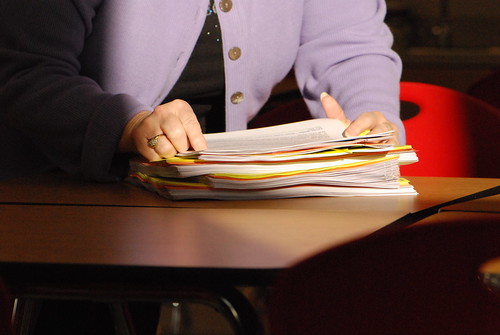 I’m a recent graduate. A school district where I would really like to teach has an opening for a secondary science teacher. But when I read the job description, the position requires teaching five classes of two different subjects (general biology and an environmental science elective). During student teaching, I just taught biology. Is it common for teachers to have more than one subject? How can I do this? I felt overwhelmed with just one! –L., California
I’m a recent graduate. A school district where I would really like to teach has an opening for a secondary science teacher. But when I read the job description, the position requires teaching five classes of two different subjects (general biology and an environmental science elective). During student teaching, I just taught biology. Is it common for teachers to have more than one subject? How can I do this? I felt overwhelmed with just one! –L., California
I’ve worked with many schools where teaching more than one subject is the rule rather than the exception. In smaller 7-12 buildings, there may be only one or two science teachers for all of the classes! Even in larger schools, it’s very common for teachers to have multiple preparations, based on student enrollment in required courses, the scope of electives offered, the teacher’s area(s) of certification, and sometimes his or her seniority.
In my own experience, I taught both life and physical science for several years, and at the high school I once had three different preparations, plus mentoring independent study. Even at the university level I taught two to three different courses each semester. I understand your concern.
And don’t forget elementary teachers who routinely plan four or more subjects (reading/language arts, math, science, and social studies) every day!
As you learned in student teaching, the obvious advantage of teaching one subject is you can concentrate all of your time and effort on a single preparation. You’ll have one lesson plan, one system of assessments, and one set of lab activities. The disadvantage is the time you’ll need to evaluate student work with the same due date. When I taught six classes of life science, I often spent Saturdays at school grading 150 projects or lab notebooks, in addition to the paperwork I would take home or review electronically.
A disadvantage to teaching more than one subject is the preparation time. You’ll need separate unit plans, lessons, and lab activities for each. But an advantage is that with careful planning you can schedule separate dates for tests, projects, lab investigations, student presentations, and notebook reviews, spreading out the evaluation work and preserving some of your sanity!
I actually enjoyed teaching more than one subject. When I taught six sections of life science, I found that by the end of the day, it was hard to remember what we discussed in each class. I had to have the energy to make the last period as engaging as the first, and I had to remember that even if I had heard a question five times already, to a student in the last class it was a new idea. I found that teaching more than one subject was intellectually challenging, and I appreciated the opportunity to update my own content and skills in more than one area.
There are many strategies you can use to keep yourself (and the students) organized. Try not to set up and conduct two different labs on the same day. Divide your bulletin boards and shelves into two separate areas so that students know where things are and where to turn in their assignments. I used a different logo for each course, putting it in the upper right corner of handouts, quizzes, or other documents. I used separate folders (with the same logo) on my laptop and separate three-ring binders for each course to organize lesson plans and other resources. I also had a tote bag for each course to keep materials from getting mixed up.
It also helps if the subjects are in consecutive periods (e.g., bio in the morning, the other class in the afternoon), so that you can keep lab materials set up—a question to ask during the interview. Otherwise, you will have to secure the materials when the other class comes in.
As a beginning teacher, your first year or two will be overwhelming, no matter how many subjects you teach! But as many of our veteran colleagues will attest, after a year or two it gets becomes more manageable. I’m hoping you would have a mentor or supportive administrator to help you, and NSTA’s e-mail lists, discussion forums, and publications can provide support and suggestions.
 I’m a recent graduate. A school district where I would really like to teach has an opening for a secondary science teacher. But when I read the job description, the position requires teaching five classes of two different subjects (general biology and an environmental science elective). During student teaching, I just taught biology. Is it common for teachers to have more than one subject? How can I do this? I felt overwhelmed with just one!
I’m a recent graduate. A school district where I would really like to teach has an opening for a secondary science teacher. But when I read the job description, the position requires teaching five classes of two different subjects (general biology and an environmental science elective). During student teaching, I just taught biology. Is it common for teachers to have more than one subject? How can I do this? I felt overwhelmed with just one!



